Hello and welcome to Maharashtra Discovery! Today, we’re going on a special journey to explore five important Jyotirlinga in Maharashtra. These places are very sacred to many people. I’ve personally been to Bhimashankar, Grishneshwar, and Trimbakeshwar, and I felt a wonderful sense of peace there. I want to share this experience with you, along with information about the other two Jyotirlinga. So, let’s begin our adventure to discover these special places in Maharashtra.
What is Jyotirlinga?
A Jyotirlinga is a sacred representation of Lord Shiva in Hinduism. The word is a Sanskrit compound of “jyotis,” meaning light, and “linga,” which signifies a sign. It’s a divine source of light and energy that symbolizes his presence and power. According to the ancient texts, there are as many as 64 Jyotirlinga, but twelve are very famous. These Lingas are Swayambhus, meaning the self-originated ones.
The twelve Jyotirlinga sites take the names of their respective presiding deity, and each is considered a different manifestation of Shiva. Devotees believe that visiting these sites and offering prayers can bring spiritual blessings and inner peace. These Jyotirlinga hold a special place in the hearts of millions, representing the eternal connection between the divine and the devotee.
1. Bhimashankar Jyotirlinga:
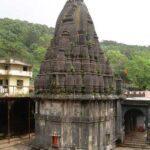
I was fortunate to visit Bhimashankar Jyotirlinga in Maharashtra. It’s nestled among the mountains and surrounded by lush greenery. The temple there stands tall and unique, built in a special way to show reverence to God. People visit this place to pray and find a sense of calm and peace within themselves. The feeling I experienced there was so serene and comforting. It’s like a quiet getaway for the soul, where the surroundings encourage you to sit and reflect.
Bhimashankar Mandir, also known as Bhimashankar, is a temple dedicated to Lord Shiva. It’s situated in the village of Bhimashankar, located in the Pune district of Maharashtra, India. This temple sits atop a mountain, and it’s about 110 kilometers away from Pune city. The area around the temple is home to rare plant and animal species, making it even more special.
The Bhima River, which holds significance in Hindu mythology, actually originates from the Bhimashankar village. Chimaji Appa, the brother of Bajirao I, generously donated a large bell to the temple, which can be seen right in front of it. The temple’s history dates back to the 13th century, and over time, additional features were added by Nana Phadnavis, a prominent figure in the Maratha Empire, during the 18th century.
Even the great Maratha ruler, Chhatrapati Shivaji Maharaj, is believed to have supported the worship at this temple through his contributions. Bhimashankar’s importance extends to being declared a wildlife sanctuary due to its rich biodiversity. Being a part of the Western Ghats, this area is teeming with diverse plant and animal life, making it a haven for nature enthusiasts.
In essence, Bhimashankar Jyotirlinga not only offers a spiritual retreat but also stands as a testament to the rich history, cultural significance, and natural beauty of Maharashtra.
2. Grishneshwar Jyotirlinga:
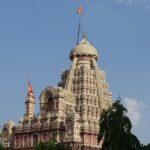
Grishneshwar is another special place I visited. The temple there is really old and has wonderful designs on it. The people who built it were truly skilled. Going to Grishneshwar felt like traveling back in time. It was like being a part of history. The feeling of being near something very holy is strong there. People from many places visit Grishneshwar to show their love and dedication to God.
The temple was rebuilt many times because of battles. The final version that we see today was built in the 18th century. Queen Ahilyabai Holkar of Indore helped rebuild it after the Mughal Empire fell. It’s a really important place for Hindus, and a lot of devotees visit it every day.
The Grushneshwar Jyotirlinga Mandir is made with black stone and covers an area of about 44,000 square feet. There are many sculptures and beautiful designs on its inside and outside walls.
The temple is located in the Verul village of the Sambajinagar district. Near this temple, there are also the Ellora Caves. These caves are recognized by UNESCO as a world heritage site. You can visit them after you’re done at the Grishneshwar temple.
3. Trimbakeshwar Jyotirlinga:
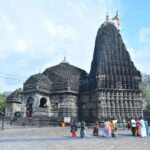
This is a wonderful place I visited near Nashik that brought a sense of calmness to my mind.
The Trimbakeshwar Jyotirlinga is a very old and important temple in Maharashtra, India. It’s around 28 kilometers from Nashik city and 40 kilometers from Nashik Road. This temple is quite special because it’s connected to the Godavari River, which is a big river. There’s a special pond called Kusavarta in the temple area, and this pond is believed to be where the Godavari River begins.
The temple is on a land surrounded by three hills: Brahmagiri, Nilagiri, and Kalagiri. It’s a big place, with gates on all four sides – East, West, South, and North. The biggest gate is on the North side. Between the gates on the west and south sides, there’s a nice lake called Amrut Kund. People use water from this lake for worship. The temple itself is in the middle and looks towards the East. It’s 96 feet tall and has a wide round part on top. The temple’s main part is 185 feet across.
There are three golden pinnacles and a special flag on top of the temple. Right in front of the main temple, there’s a small temple for Nandi, who is like a good friend to Lord Shiva. Inside the temple, there’s a pretty hall with a round roof. If you go down five steps inside, you can see a natural and beautiful Shiva linga, which is a symbol of Lord Shiva.
There are three smaller lingas too, each like the size of a thumb. They show the three main gods: Brahma, Vishnu, and Mahesh. Water keeps flowing from one of these lingas, which is really special. On the east side of this Jyotirlinga, there’s a statue of Goddess Parvati made of marble.
4. Nagnath Jyotirlinga in Aundha:
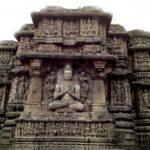
The Aundha Nagnath temple, also called Nageshwaram, is the eighth Jyotirlinga among the twelve well-known Jyotirlingas. This Jyotirlinga In Maharashtra is located in Aundha Taluka, Hingoli District. This temple, known as Aundha Nagnath, was built around the 13th century and is found in the Hingoli district. The temple’s architecture is unique and has intricate designs. It’s made using dry masonry style, which means stones are carefully arranged without any mortar.
Long ago, during the time of the Mughal king Aurangzeb, the temple faced destruction. But thanks to the efforts of Queen Ahilyabai Holkar, it was repaired. The temple stands within a protective area. Some parts needed repair, and those were fixed. Even so, the temple preserves its ancient grandeur. The pillars and outer walls are adorned with beautifully carved designs. At the entrance, there are splendid sculptures of elephants. Near the temple, you’ll see a special ritual lake.
Inside the temple, you can find images of various gods like Vishnu, Shiva, and Brahma. The main part of the temple is hidden underground, possibly built that way to safeguard it from invaders in the past. When you enter, you need to go down a few steps through a narrow path. Inside, there’s a chamber with four pillars, and in the center of these pillars, the sacred shivlinga is placed. This shivlinga is the main deity of the temple and is worshipped with devotion.
5. Parli Vaijnath Jyotirlinga:
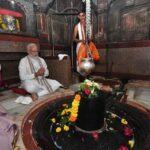
The Parli Vaijnath Jyotirlinga in Maharashtra is an important place to worship. “Vaijnath” means a great healer or doctor. It’s the ninth among the twelve famous Jyotirlingas. It’s in Parli Taluka, Beed District, Maharashtra, India. This temple is very special to many people. The Parli Vaijnath temple is old and has deep connections with religion.
The temple is made of stone and is on a little hill. Walls surround it to keep it safe. We don’t know exactly when it was built, but experts think it’s from around 12th or 13th century CE. Records say that Queen Ahilyabai Holkar fixed it in 1706. The temple looks very nice and has special ponds around it. One pond, called Harihara Teerth, has water poured on the Shivlinga.
In 2019, even the Prime Minister came to this temple. This showed how important the temple is for our culture and faith.
These Jyotirlinga in Maharashtra hold stories of faith that have been passed down through generations. Whether you’re finding peace at Bhimashankar, exploring the ancient charm of Grishneshwar, feeling the natural power at Trimbakeshwar, or experiencing the sacredness of Parli Vaijnath and Nagnath Jyotirlinga in Maharashtra Aundha, each site has its own unique magic.
As our journey comes to an end, let’s not forget the importance of these sacred sites. They teach us to respect our ancestors’ heritage and the efforts they put into building and maintaining these temples.
We would love to hear about your experiences. Please share your thoughts in the comments when you visit these locations. Your stories could inspire others to explore these spiritual treasures.
Frequently Asked Questions (FAQ) about Jyotirlinga in Maharashtra
Q1: How many Jyotirlingas are there in Maharashtra?
There are five Jyotirlinga in Maharashtra.
Q2: Where are the five Jyotirlinga in Maharashtra located?
The five Jyotirlinga in Maharashtra are Bhimashankar, Grishneshwar, Trimbakeshwar, Parli Vaijnath, and Aundha Nagnath.
Q3: Where is the Trimbakeshwar Jyotirlinga in Maharashtra located?
The Trimbakeshwar Jyotirlinga is situated near the town of Trimbak in Nashik district.
Q4: How can I complete visiting all five Jyotirlinga in Maharashtra?
To visit all five Jyotirlinga in Maharashtra, you can plan a travel itinerary covering Bhimashankar, Grishneshwar, Trimbakeshwar, Parli Vaijnath, and Aundha Nagnath. You can choose to travel by road or train, exploring the unique beauty and spirituality of each destination.
Q5: What is the name of the 12 Jyotirlinga?
- Somnath
- Nageshvaram
- Mahakaleshwar
- Omkareshwar
- Mallikarjuna
- Ramanatha Swamy
- Kedarnath
- Bhimashankar
- Trayambakeshwar
- Grishneshwar
- Baidyanath
- Vishwanath
Q6: Which Jyotirlinga is in Pune?
The Bhimashankar Jyotirlinga in Maharashtra is located near Pune in the Sahyadri Mountains.
Q7: Which Jyotirlinga In Maharashtra should I visit first?
There is no specific order to visit the Jyotirlingas. You can start with any Jyotirlinga that resonates with you or fits your travel plans.
Q8: Which Jyotirlinga is considered the most powerful?
All Jyotirlingas are equally revered, and their significance is deeply rooted in mythology and spirituality. There is no distinction of power among them.
Q9: Which Jyotirlinga is less crowded?
The crowd at Jyotirlingas can vary depending on the time of year and special festivals. Generally, the crowd is manageable at most Jyotirlingas, but it’s advisable to plan your visit during weekdays or offseason for a less crowded experience.
Q10: Why is Bhimashankar famous?
Bhimashankar is famous for its Jyotirlinga temple dedicated to Lord Shiva. It’s also renowned for its natural beauty as it’s situated in the scenic Western Ghats.
Q11: Which city is closest to Bhimashankar?
Pune is the closest major city to Bhimashankar, making it a convenient starting point for your journey.
Q12: Is Mahabaleshwar a Jyotirlinga?
No, Mahabaleshwar is not a Jyotirlinga. However, Mahabaleshwar does have an ancient temple dedicated to Lord Shiva, which is known as the Mahabaleshwar Temple. This temple holds historical and cultural significance
Explore more of Maharashtra’s spiritual treasures at these links
Ancient Ambarnath Temple: A Glimpse into the Past – https://maharashtradiscovery.com/ancient-ambarnath-temple-blog/
Kondeshwar Temple: Where Sacredness Meets Nature’s Bliss – https://maharashtradiscovery.com/kondeshwar-temple-sacred-bliss-nature/
Connect with us on our Facebook page for more updates and insights https://www.facebook.com/profile.php?id=100094690564721
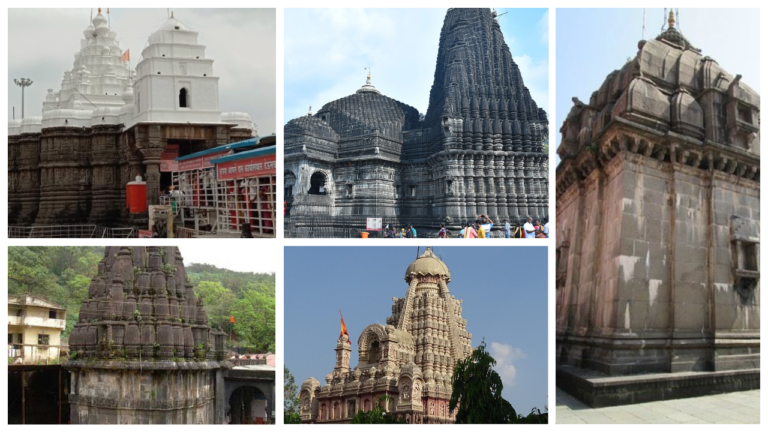
1 thought on “5 Holy Jyotirlinga In Maharashtra | महाराष्ट्रातील 5 ज्योतिर्लिंगांबद्दल माहिती”